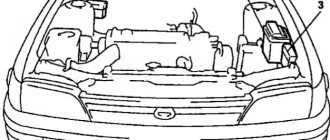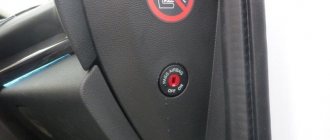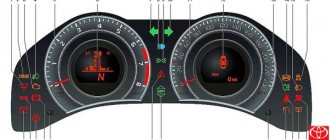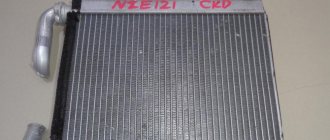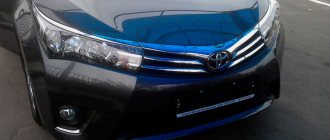Fielder how to view the body number
The Toyota Corolla Fielder has an identification plate (B) and vehicle identification number (A) under the hood as shown in the illustration and photo.
And also on the next page there is information where the Fielder engine number and gearbox number are located, depending on the engine type.
Decoding the Corolla Fielder
TA is a designation for the certification of a Toyota for compliance with environmental standards.
TA - for gasoline engines since 2000;
KE - for diesel engines since 1997.
NZ - designation of engines of the “NZ” series (1NZ-FE; 2 NZ-FE)
ZZ - designation of engines of the "ZZ" series (1ZZ-FE)
C - engines of the "C" series (3 C-E) - diesel
E - Corolla
121 G - model generation designation, engine included and drive
| engine | checkpoint | Drive unit | Code | |
| NZE 121 G | 1NZ-FE | C51 | 2WD | —AWMNK |
| NZE 121 G | 1NZ-FE | U340E | 2WD | — AWPNK |
| ZZE 122 G | 1ZZ-FE | C52 | 2WD | —AWMEK |
| ZZE 122 G | 1ZZ-FE | U341E | 2WD | —AWPEK |
| ZZE 123 G | 2ZZ-GE | C60 | 2WD | —AWFQF |
| ZZE 123 G | 2ZZ-GE | U240E | 2WD | AWPQF |
| CE 121G | 3 C - E | U341E | 2WD | — AWPNE |
| NZE 124 G | 1NZ-FE | U340F | 4WD | — AWPNK |
| ZZE 124G | 1ZZ-FE | U341F | 4WD | —AWPEK |
A - Corolla - sedan, Corolla Fielder - station wagon, Corolla Runx - hatchback;
W - station wagon; E - sedan; H - hatchback.
M - mechanical, 5 steps; F - mechanical, 6 steps.
K - gasoline engine with distributed fuel injection, DONC (1NZ-FE; 2NZ-FE; 1ZZ-FE)
F - gasoline engine with distributed fuel injection, DONC, Twincam (2 ZZ-GE)
E - diesel engine, with electronically controlled injection pump (3 C-E)
Source
Body E150
For different types of E150 body engine, the location of the plate will be different.
Since mid-1981, all Toyota models that were exported to Europe and the USA had a 17-digit identification number. There are differences between the license plates of cars intended for the European market and those for the American market.
The VIN code is located in the upper left part of the instrument panel, visible through the windshield.
1. Vehicle model 2. Engine model 3. VIN code or body number 4. Paint code 5. Trim code 6. Transmission code 7. Final drive code 8. Manufacturer's code
Source
Toyota Corolla E150 – VIN location and engine number MARKING
The search for a good copy of the Toyota Corolla E150 usually drags on for months. However, if you find something worthwhile on the market, do not rush into fanfare and shell out your hard-earned money to the seller without properly looking at the forensic markings. There are so many stolen and damaged copies traveling around our country that the chance of running into a problem and being left without a car and money is extremely high, especially if you come across a worthwhile option at a “sweet” price.
Just like its fellow Auris, the Toyota Corolla E150 hid the main VIN number in the usual place for the Japanese brand - under the front passenger seat:
The symbols are machined onto the transverse strip of the body, which could simply have been welded here from another car, which means that not only the letters with numbers need to be examined for validity, but also the fasteners themselves, which are spot welded. To do this, you will have to dismantle part of the decorative trim on the threshold of the right front door:
Remove the cover
Spot welding of fastening
Traces of torsional seat bolts do not mean a crime, but it is a reason to check the car even more carefully:
A duplicate metallized nameplate with the VIN designation is mounted in the driver's door opening under the outer hinge of the lock. Usually the sticker is firmly attached and even the least careful car washers cannot easily damage it:
The nameplate carries information about the equipment, trim and color of the body. Compare the data with what is actually in the car
An ultraviolet mark along the contour is used as protection against re-sticking:
Source
What is a VIN code and what information does it contain?
The VIN code (short for Vehicle Identification Number) is a combination of 17 Arabic numbers and Latin letters.
Information is applied to body panels that cannot be removed without destroying the structure, or on special stickers or metal plates. The elements are installed with rivets (the fastening heads are compressed with a factory tool, which is difficult to counterfeit).
The VIN code for Toyota and any other car includes information about:
- manufacturer;
- modifications (in encoded form);
- model year;
- the factory that assembled the car;
- serial number.
Bumper data
| Scratches | A1 | There are scratches on the bumper. |
| A2 | One third of the bumper surface is covered with scratches. | |
| A3 | There are a lot of scratches. | |
| Cracks | Y1 | There are cracks in two places. |
| Y2 | There are quite a lot of cracks. | |
| Y3 | There are a lot of cracks, some have been restored. | |
| Dents | U1 | Small dents, dents, abrasions |
| U2 | Dents. | |
| U3 | Large dents, large dents, significant abrasions. | |
| Recovery | W1 | Everything has been restored well. |
| W2 | Irregularities in the restoration areas are noticeable. | |
| W3 | Restored crookedly, bumper needs to be repainted. |
Almost always, the auction sheet contains a schematic representation of the body, and in expanded form.
Auctioneer transcript
Location of the car serial number
The location of the code on Toyota vehicles depends on the year of manufacture and the sales market. For example, the sticker on the Camry XV40 or Corolla E150 is located under the windshield on the driver’s side (accordingly, the installation location of the element differs for the right-hand and left-hand steering wheels).
On the Corolla E120 or Altezza (the model intended for the Japanese domestic market), the information is printed on metal labels mounted on rivets on the engine side of the engine shield.
On the dashboard
If the instrument panel is used to apply the code, then there is a recess on the plastic for installing a metal element or a sticker printed on special paper. When assembling the car, the main identifier is simultaneously cut on the body and additional labels are stuck on. The ferrite coating applied around the perimeter of the windshield has a rectangular cutout through which the vehicle's VIN code can be read.
Manual VIN decoding of Toyota European type
The car owner can decipher each character of the license plate using tables. It should be taken into account that the Toyota company changed the meaning of a number of characters in the encoding in 2002. Identifiers for machines supplied to Europe or North America also have a number of differences.
Regardless of the car’s release date, the identifier is usually divided into sections WMI (first 3 characters) and VDS (the next 6 characters) and an auxiliary field (8 characters).
Character table with meaning before 2002
The table shows the structure of the VIN identifier for Toyota products used before 2002.
| Character position in identifier | Decoding |
| From 1 to 3 | Designation of the vehicle manufacturer (WMI index, which included numbers and letters) |
| From 4 to 5 | Body type identification mark (both numbers and letters were used) |
| 6 | Engine code, which allows you to determine the generation of the power unit (letters were used for identification) |
| 7 | Model line of the car (indicated only by a letter of the Latin alphabet) |
| 8 and 9 | Model serial identifier designation |
| 10 | Reserve position (digit 0 was used) |
| From 11 to 17 | Machine serial number |
For example, the owner has a Toyota Carina with VIN number JT1LSTBK001234567, when decrypted you can get the following information:
- JT1 - a passenger car produced by the company for the European market;
- LS - a 5-door liftback body was used;
- T - a 2T or 3T generation engine is installed (they differ in displacement and fuel supply system, which are specified according to the documents for the vehicle);
- B - the car belongs to the Carina-Avensis model line;
- K0 - Carina E model (T190 generation);
- 0 — reserve position;
- 1234567 - serial number.
After 2002
Since 2002, the structure of the VIN code used by the Toyota concern has changed somewhat.
The data is shown in the table.
| Character position in identifier | Decoding |
| From 1 to 3 | WMI index, which allows you to clarify the world index of the car manufacturer |
| 4 | Type of body used and drive scheme (4x2 or 4x4) |
| 5 | Power unit identifier (Latin letter) |
| 6 | The serial number of the series (for example, the number 2 is used to designate the Land Cruiser Prado J120) |
| 7 | Features of the installed airbag system (allows you to determine the number and location of elements) |
| 8 | Model identifier (number or letter of the Latin alphabet) |
| 9 | Checksum sign |
| 10 | Model year identifier (information may be omitted, in this case the number 0 is entered) |
| 11 | Manufacturer (factories in Japan are reserved for numbers from 0 to 9; factories around the world are indicated by a letter) |
| From 12 to 17 | Machine serial number |
For example, the owner has a Corolla E120 car with the identifier SB1BZ28E53123456, the decoding of which allows one to obtain information that:
- SB1 - the car was produced by Toyota;
- B - the car is equipped with a 4-door sedan body and 1 axle drive;
- Z - under the hood there is a 16-valve 4-cylinder engine of the 1ZZ-FE or 3ZZ-FE series (differing in displacement);
- 2 - E120 series identifier;
- 8 — the cabin is equipped with front and side airbags;
- E - Auris or Corolla model (built on 1 platform, different bodies);
- 5 - determinant of the checksum, which is calculated using a special algorithm;
- 3 - the car belongs to the 2003 model year;
- 123456 - serial number.
Features of Toyota vehicle identification number
The VIN code consists of 17 characters, including both letters and numbers.
The first three positions in the issue are reserved for the world manufacturer index - WMI. A possible manufacturer index for Toyota cars can be JHD, JT1, JT2, JT3, JT4, JT5, JT7, JTA, JTB, JTC, JTD, JTE, JTF, JTG, JTH, JTJ, JTX, JYF, LCU, MR0, SB1 . The decoding of this index is as follows.
The first position determines the country of origin. For example, J stands for Japan, S for Great Britain.
The second position indicates the plant where the car was manufactured (T - Toyota).
The third position allows you to find out the region in which the car was produced. For example, “1” stands for Europe, “2” for USA/Canada, “3”, “4”, “8”, “B”, “C” for Gulf countries, “7” for Australia and third world countries , “0” – Taiwan or Singapore.
Plate containing VIN code
The fourth and fifth positions in the VIN code allow you to determine the body type of a given Toyota model. The decoding of such designations is quite simple. So, a jeep or minivan with a standard roof is designated by number 11, with a raised roof – by number 12. If the number 21 or 22 is in 4-5 positions, this is a cargo bus (Hiace) with a standard or raised roof, respectively. A pickup truck (Hilux) or a truck (Dyna) with a single cab has the number 31, with a one-and-a-half cab - 32, with a double cab - 33. Number 41 is encrypted for a bus (Hiace Commuter, Coaster) with a standard roof, number 42 - with a raised roof, 43 – with a high roof. More traditional bodies begin with number 52. So, the number 52 means that this car was made in a hatchback body with two doors, 54 - with four doors. For sedans (Corolla), the manufacturer provided the number 53. The coupe is produced under the body number 63, the liftback - 64, and the station wagon - 72.
North American Market Breakdown
For vehicles sold in the US and Canadian markets, a modified coding is used to comply with local regulations. The initial version of identifiers for cars was introduced in 1981 and lasted until the end of 1995. Starting in 1996, changed markings began to be used (in a number of sources, the date of change in the structure of the number is erroneously assigned to 2002, by analogy with Europe).
Symbols before 2002
The structure of early type identification markings is shown in the table.
| Character position in identifier | Decoding |
| From 1 to 3 | WMI index to determine the world machine manufacturer index |
| 4 | Engine model identifier |
| 5 | Letter indicating model or platform |
| 6 | Model generation |
| 7 | A letter or number that allows you to clarify the model’s equipment |
| 8 | Body type coding |
| 9 | Check number |
| 10 | Model year |
| 11 | Vehicle assembly location |
| From 12 to 17 | Machine serial number |
For example, based on the code JT2FK14F8LN123456, you can get the following data:
- JT2 - the machine was assembled for the US and Canadian markets;
- F - 1MZ-FE engine used;
- K - the car is built on the Camry platform;
- 1 — the car belongs to the MR2/Camry or SXV10 generation (to be specified by date of assembly);
- 4 — standard equipment is used;
- F - a 4-door sedan body was used;
- 8 - determinant of the checksum, which is calculated using a special algorithm;
- L - 1990 model year;
- N - the car is assembled at the plant in Georgetown (Kentucky);
- 123456 — serial number of the copy.
Numbers after 2002
Since 1996, a number of changes have been introduced into the identifier structure, which are listed in the table.
| Character position in identifier | Decoding |
| From 1 to 3 | WMI Index |
| 4 | Body and drive type |
| 5 | Engine model |
| 6 | Series serial code number (the middle digit of the 3-digit identifier is used) |
| 7 | Description of the number of airbags |
| 8 | Model number |
| 9 | Check number |
| 10 | Model year |
| 11 | Assembly location |
| From 12 to 17 | Machine Serial ID |
For example, the VIN of the car JT2BF18K8X14F8LN123456 in decrypted form contains the information:
- JT2 - assembly for the USA or Canada;
- B — sedan body with 4 doors and 1 axle drive;
- F - 3.0-liter 1MZ-FE engine installed;
- 1 — model identifier;
- 8 — 4 airbags used;
- K - Camry model;
- 8 — checksum determinant;
- X - model corresponds to 1999;
- N - the car is assembled at the plant in Georgetown (Kentucky);
- 123456 - serial number.
Detailed information about the model in the VIN code
The sixth position in the Toyota VIN code indicates the engine series. In this case, letter designations are used. If the letter A is in this position, the motor series can be 4A or 7A. In the case of the letter B – series 3B, 11B, 13B, 14B, 15B; C – 1C, 2C, 3C. You can also decipher the remaining designations E (2E, 3E, 4E, 5E), F(3F), G (1G), H (2H, 12H), J (1JZ, 2JZ), K (5K, 7K), L ( 2L, 3L, 5L), M (5M), P (1HZ), R (22R), S (2S, 3S, 4S, 5S).
VIN code on the registration certificate
Letter designations that appear in the seventh position refer to the manufacturer's model (for example, Corolla). Decoding this position allows you to obtain the following information. So, under the letter A is “hidden” Supra, the letter B stands for Toyota Coaster. "C" is for Previa and RAV4, "D" is for Mega Cruiser. Under the symbol “E” the C-class sedan Corolla is encrypted. "H" and "K" are reserved for Hiace. "J" means the model is Land Cruiser. Under the letter L are encrypted Paseo, Tercel, M – Picnic, N – Hilux, P – Starlet, R – Liteace. The T designation is intended for models such as Carina, Corona, Celica, Avensis. The letter U means Dyna 200. The brand's favorite Camry is assigned the letter V. The remaining designations (W, X, Y) mean models such as MR2, Cressida, Dyna 100, Dyna 150.
The eighth and ninth positions indicate the model code and are written as second ten numbers. For example, letter A = 10, B = 11, C = 12, D = 13, E = 14 (Corolla), F = 15, G = 16, H = 17, J = 18, K = 19, L = 20 , N = 22, etc. In modern models (for example, the 11th generation Toyota Corolla) some letter designations are not used and N is considered the last character. This decoding reads as follows: A0 = 100, A1 = 101, B0 = 110, N1 = 221, etc.
As for the 10th position , there is a spare symbol on it. As a rule, it is not used and is marked with the number 0.
Positions 10 to 17 in the VIN code indicate the production number of the product.
Thus, the VIN code is the number of each model of the Toyota manufacturer, which encrypts the necessary information about a specific car (for example, Toyota Corolla). The VIN code allows you to find out the country and region of production, plant, body type and model, engine series and other information.

